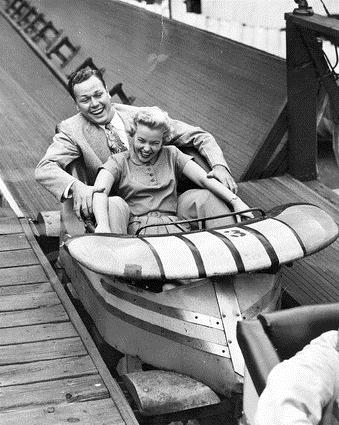There's actually quite a bit more than meets the eye to why Flying Turns took so long to open, and it isn't because the trains "hated everyone" or everyone hated the trains or whatever.
First, one must realize that the original flying turns rides from the 20's and 30's had an EXTREMELY dangerous design. It was a chair mounted to a board mounted to a chassis. The chassis' pivot point was in such a spot that numerous cavities and pinch points were present:
The trains had to be completely redesigned from the ground up, although they tried to keep them as realistic to those from the past. Of course, the trains went through a few iterations before finally reaching their current design. Their first design was taller than the current design and so they could not be subject to too extreme of dynamics.
Honestly, these trains probably would have been successful if it weren't for one relatively unknown fact about the flying turns design. The trains have a natural frequency associated with their swaying (the exiting of one turn and entering into another). Unfortunately, someone changed the dimension of the straight between turns. This change threw off the natural frequency, resulting in the train attempting to enter the curve too early, leveling out, experiencing too high of dynamics when it actually entered the turn, and resulted in the train rolling upon hitting the hard stop on the top of the trough. Their big challenge for years was figuring a way to damp the trains such that they properly entered each turn.
The current design takes everything into account. Not only does it eliminate the awkward pivot point found on the old ones as well as provide proper damping for entering the turns, but also has numerous redundancies designed in. This photo does not quite show the redundancies perfectly, but many nuts, slip rings, cotter pins, etc are all doubled up to ensure that the trains were as safe as possible:
Notice how each caster is mounted to a rocker. Hidden behind that rocker are springs which oppose any motion caused by the caster pivoting. There are eight casters on each car - the design tries to keep each as straight as possible to elongate the natural swaying frequency of the train.
Seeing as how this quirk took so long to get worked out, they want to make sure it stays under control. There is a thermal system under the station floor - when it is hot, they blow cold air on the casters and vice versa. They have a system that records the train's time from when it leaves the first lift until it arrives at the second lift. The time is then utilized in an algorithm to determine how much to slow down the lift as the train nears the top. A faster or slower than average travel time through the first portion of the ride suggests that the train will not properly hit its mark and so the speed of the lift is adjusted. They do not want any variables in the operation with the ride.
But yeah, Knoebels faced many challenges with Flying Turns which Zierer will not face with Impulse. If Impulse does happen to have train issues, it will be a bizarre, unfortunate, and funny coincidence.













